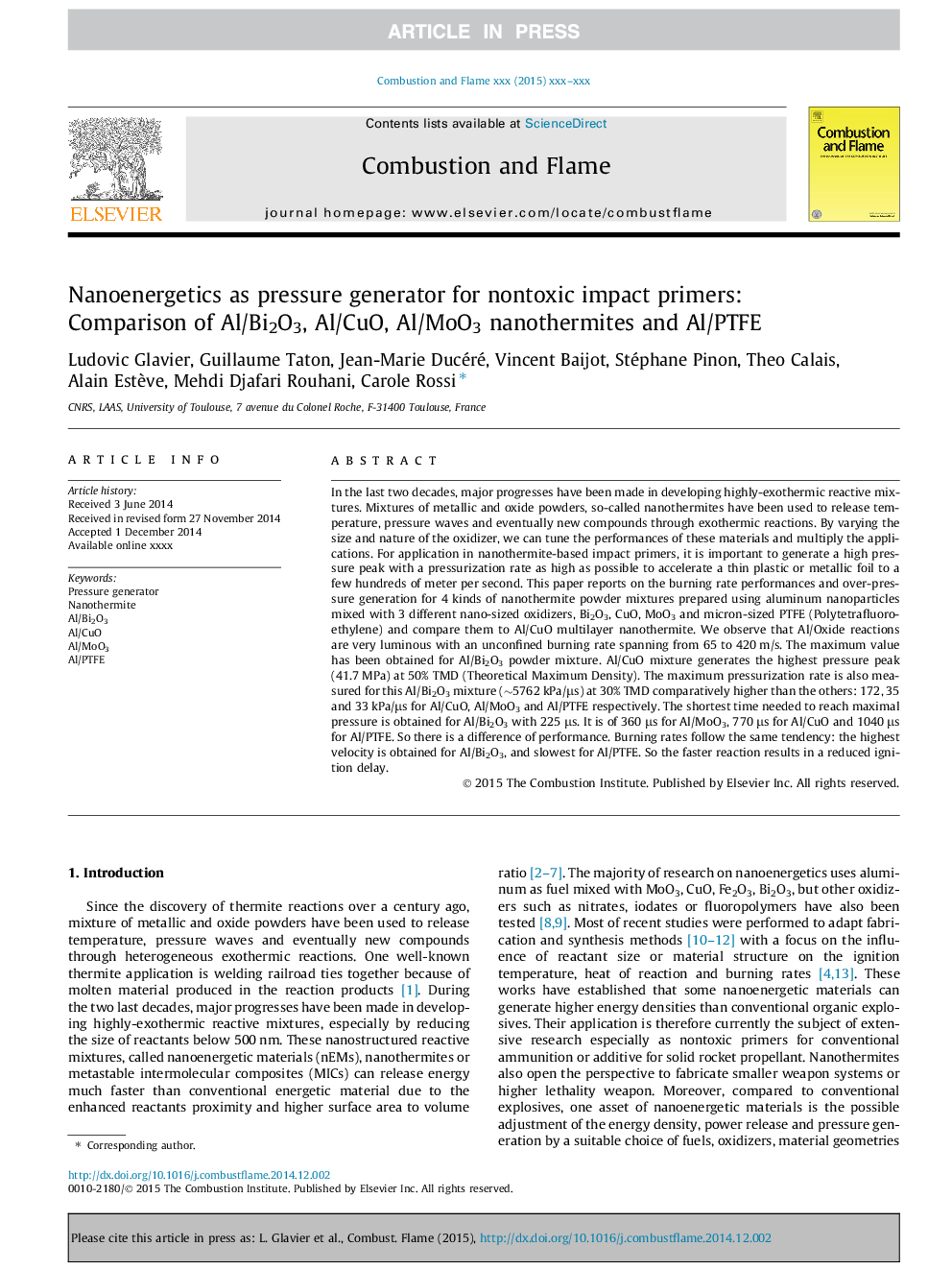| کد مقاله | کد نشریه | سال انتشار | مقاله انگلیسی | نسخه تمام متن |
|---|---|---|---|---|
| 10264286 | 457756 | 2015 | 8 صفحه PDF | دانلود رایگان |
عنوان انگلیسی مقاله ISI
Nanoenergetics as pressure generator for nontoxic impact primers: Comparison of Al/Bi2O3, Al/CuO, Al/MoO3 nanothermites and Al/PTFE
دانلود مقاله + سفارش ترجمه
دانلود مقاله ISI انگلیسی
رایگان برای ایرانیان
کلمات کلیدی
موضوعات مرتبط
مهندسی و علوم پایه
مهندسی شیمی
مهندسی شیمی (عمومی)
پیش نمایش صفحه اول مقاله

چکیده انگلیسی
In the last two decades, major progresses have been made in developing highly-exothermic reactive mixtures. Mixtures of metallic and oxide powders, so-called nanothermites have been used to release temperature, pressure waves and eventually new compounds through exothermic reactions. By varying the size and nature of the oxidizer, we can tune the performances of these materials and multiply the applications. For application in nanothermite-based impact primers, it is important to generate a high pressure peak with a pressurization rate as high as possible to accelerate a thin plastic or metallic foil to a few hundreds of meter per second. This paper reports on the burning rate performances and over-pressure generation for 4 kinds of nanothermite powder mixtures prepared using aluminum nanoparticles mixed with 3 different nano-sized oxidizers, Bi2O3, CuO, MoO3 and micron-sized PTFE (Polytetrafluoroethylene) and compare them to Al/CuO multilayer nanothermite. We observe that Al/Oxide reactions are very luminous with an unconfined burning rate spanning from 65 to 420 m/s. The maximum value has been obtained for Al/Bi2O3 powder mixture. Al/CuO mixture generates the highest pressure peak (41.7 MPa) at 50% TMD (Theoretical Maximum Density). The maximum pressurization rate is also measured for this Al/Bi2O3 mixture (â¼5762 kPa/μs) at 30% TMD comparatively higher than the others: 172, 35 and 33 kPa/μs for Al/CuO, Al/MoO3 and Al/PTFE respectively. The shortest time needed to reach maximal pressure is obtained for Al/Bi2O3 with 225 μs. It is of 360 μs for Al/MoO3, 770 μs for Al/CuO and 1040 μs for Al/PTFE. So there is a difference of performance. Burning rates follow the same tendency: the highest velocity is obtained for Al/Bi2O3, and slowest for Al/PTFE. So the faster reaction results in a reduced ignition delay.
ناشر
Database: Elsevier - ScienceDirect (ساینس دایرکت)
Journal: Combustion and Flame - Volume 162, Issue 5, May 2015, Pages 1813-1820
Journal: Combustion and Flame - Volume 162, Issue 5, May 2015, Pages 1813-1820
نویسندگان
Ludovic Glavier, Guillaume Taton, Jean-Marie Ducéré, Vincent Baijot, Stéphane Pinon, Theo Calais, Alain Estève, Mehdi Djafari Rouhani, Carole Rossi,